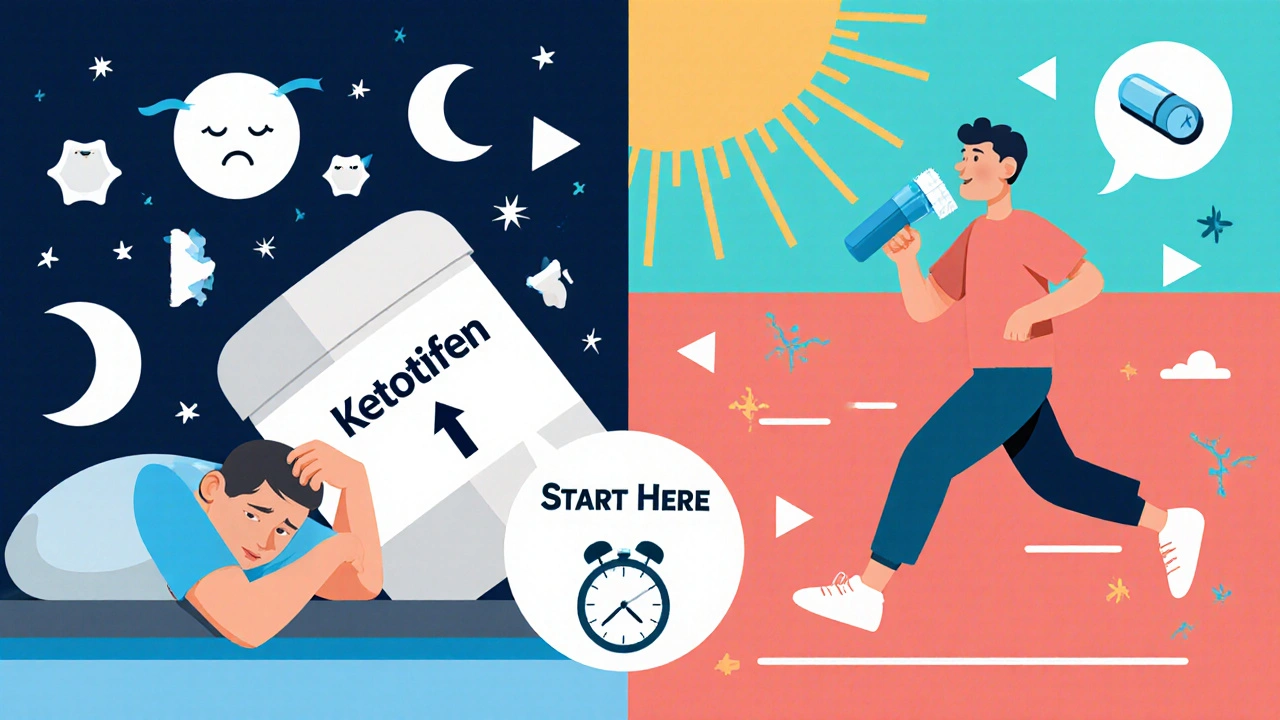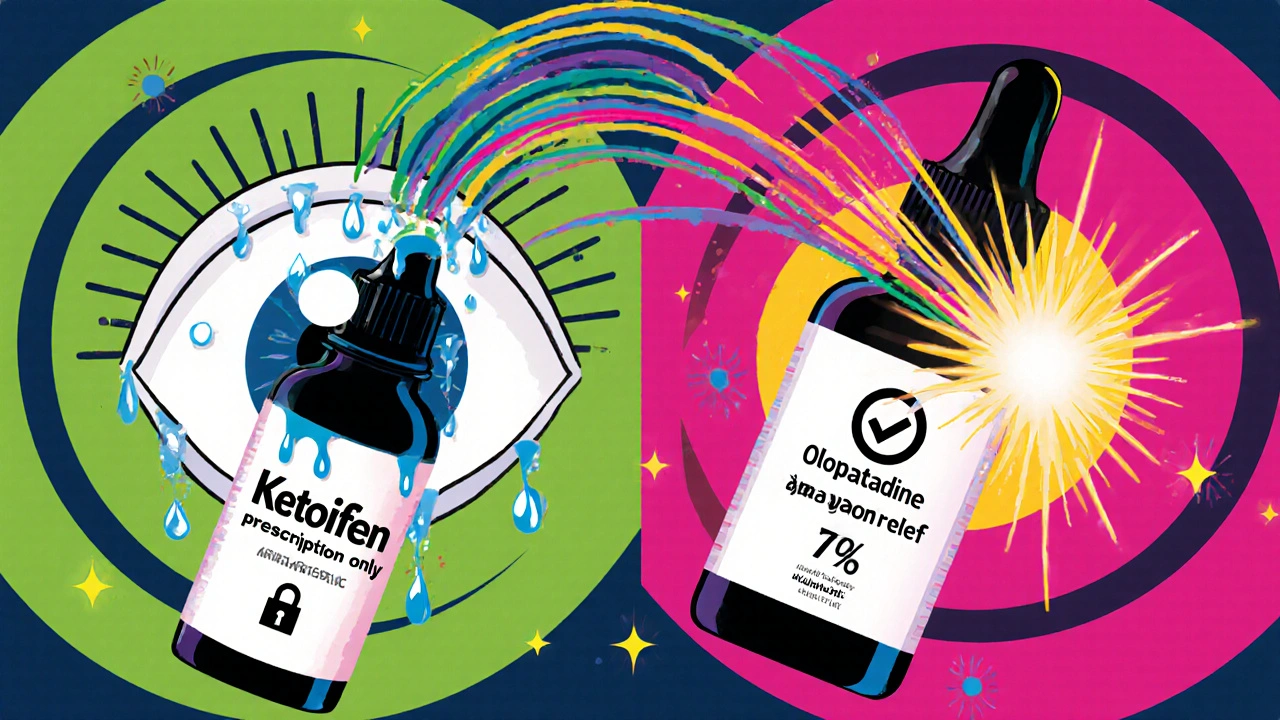When your allergies flare up or your asthma acts up, you don’t want to waste time guessing which medication works. Ketotifen is one option - but it’s not the only one. And for many people, it’s not even the first choice. So how does Ketotifen stack up against other treatments? Let’s cut through the noise and compare what’s actually out there, based on real-world use, clinical data, and what doctors recommend today.
What Ketotifen Actually Does
Ketotifen is a dual-action medication that blocks histamine receptors and stabilizes mast cells. Also known as Zaditen, it was first approved in the 1980s and is still used today, especially outside the U.S. Unlike regular antihistamines like loratadine or cetirizine, Ketotifen doesn’t just stop histamine from causing sneezing and itching. It also prevents mast cells from releasing histamine in the first place. That makes it useful for both allergic rhinitis and mild asthma.
It’s taken orally, usually once or twice a day. Some people use it as eye drops for allergic conjunctivitis. The effects build up over days, so it’s not for sudden flare-ups. It’s more of a preventive tool - like brushing your teeth to avoid cavities, not taking painkillers after a toothache.
Side effects? Drowsiness is common. So is increased appetite. That’s why it’s not the first pick for teens or people who need to stay alert. But for kids with chronic allergies, it’s often prescribed because it’s been used safely for decades.
First-Line Alternatives: Oral Antihistamines
If you’re looking for something faster, easier, and less sedating, oral antihistamines are the go-to. These include:
- Loratadine (Claritin) - non-drowsy, once-daily, available over the counter
- Cetirizine (Zyrtec) - slightly more effective for some, but can cause drowsiness in 10-15% of users
- Fexofenadine (Allegra) - least sedating of the trio, good for people who drive or work with machinery
These drugs work by blocking histamine after it’s released. They’re fast - often working within an hour. No mast cell stabilization. But they’re cheaper, more widely available, and better studied in large populations.
A 2023 review in the Journal of Allergy and Clinical Immunology found that cetirizine reduced nasal symptoms by about 50% in adults, while Ketotifen showed similar results but took longer to kick in. For daily symptom control, most doctors start here.
For Asthma: Inhaled Corticosteroids
If your main issue is asthma - especially if you’re using a rescue inhaler more than twice a week - Ketotifen isn’t enough. Inhaled corticosteroids like fluticasone (Flovent), budesonide (Pulmicort), or mometasone (Asmanex) are the gold standard.
These reduce inflammation in the airways. They don’t relieve sudden wheezing, but they prevent it. Studies show they cut asthma attacks by 40-60% over time. Ketotifen has no proven effect on airway remodeling or long-term lung function.
One key difference: Inhaled steroids require daily use for weeks before you feel the benefit. Ketotifen also needs time. But steroids have stronger evidence for preventing hospitalizations. If you have persistent asthma, skipping steroids for Ketotifen is like using a bandage on a broken bone.
Leukotriene Modifiers: Montelukast as a Close Cousin
Montelukast (Singulair) is another option that’s often compared to Ketotifen. It blocks leukotrienes - chemicals that cause airway tightening and mucus production. It’s taken as a pill once a day, often at night.
Unlike Ketotifen, montelukast is FDA-approved for both allergic rhinitis and asthma in children as young as 12 months. It’s also used for exercise-induced asthma, which Ketotifen isn’t approved for.
Studies show montelukast is slightly more effective than Ketotifen for asthma control. It’s also less sedating. But it comes with its own risks: rare reports of mood changes, anxiety, or sleep disturbances. The FDA added a black box warning in 2020.
For kids with both allergies and asthma, many pediatricians choose montelukast over Ketotifen because it’s better studied and has a broader label.

Eye Drops: Ketotifen vs Olopatadine
If your problem is itchy, watery eyes, Ketotifen eye drops (Zaditen) are effective. But they’re not the only option.
Olopatadine (Patanol, Pataday) is another mast cell stabilizer and antihistamine combo. It’s faster-acting, lasts longer (up to 16 hours), and causes less burning on application. A 2024 clinical trial found Pataday reduced eye itching by 78% after 15 minutes, compared to 62% for Ketotifen.
Pataday is also available over the counter in many countries. Ketotifen eye drops are still prescription-only in places like the U.S. and Australia. Cost and access matter.
When Ketotifen Might Still Be the Best Choice
That doesn’t mean Ketotifen is obsolete. There are situations where it shines.
- Children under 12 with chronic urticaria - it’s one of the few options with long-term safety data in young kids
- People who can’t tolerate steroids - if you’ve had bad reactions to inhaled corticosteroids, Ketotifen offers a non-steroidal alternative
- Combination therapy - some doctors add Ketotifen to a low-dose antihistamine for stubborn cases
- Cost-sensitive settings - in countries without robust insurance, Ketotifen is often cheaper than newer branded drugs
It’s also used off-label for mast cell activation syndrome (MCAS), though evidence is still emerging. Some patients report better symptom control than with antihistamines alone.
What Doctors Actually Recommend Today
In Australia, the U.S., and Europe, guidelines from the Global Initiative for Asthma (GINA) and Allergic Rhinitis and its Impact on Asthma (ARIA) don’t list Ketotifen as a first-line treatment.
Here’s what they do recommend:
- Start with non-sedating oral antihistamines for allergies
- Add intranasal corticosteroids if nasal symptoms persist
- Use inhaled corticosteroids for persistent asthma
- Consider montelukast if asthma is triggered by exercise or allergens
- Reserve Ketotifen for cases where other options fail, or for specific populations like young children
That’s not because Ketotifen doesn’t work. It’s because there are better-studied, faster-acting, and safer options for most people.

Side Effects and Safety: The Real Comparison
Let’s break down the risks side by side:
| Medication | Common Side Effects | Rare but Serious Risks | Drug Interactions |
|---|---|---|---|
| Ketotifen | Drowsiness, increased appetite, weight gain, dry mouth | Liver enzyme changes (rare) | Can increase sedation with alcohol, benzodiazepines |
| Loratadine/Cetirizine/Fexofenadine | Headache, dry mouth, mild fatigue | None significant | Fexofenadine interacts with grapefruit juice |
| Fluticasone (inhaled) | Sore throat, hoarseness, oral thrush | Adrenal suppression with long-term high doses | Minimal |
| Montelukast | Headache, stomach upset | Mood changes, depression, suicidal thoughts (FDA warning) | May interact with phenytoin, rifampin |
| Olopatadine (eye drops) | Burning sensation, bitter taste | Eye irritation, blurred vision | None significant |
For most adults, the risk profile of non-sedating antihistamines or inhaled steroids is cleaner than Ketotifen’s. But for a child with chronic hives who’s gained weight on steroids, Ketotifen might be the least bad option.
Final Take: Is Ketotifen Right for You?
There’s no one-size-fits-all answer. Here’s how to decide:
- Choose Ketotifen if: You’re a child with persistent allergies, you’ve tried other meds without success, or you need a non-steroidal option and can tolerate drowsiness.
- Choose an antihistamine if: You need quick relief for sneezing, itching, or runny nose - and you want to stay alert.
- Choose an inhaled steroid if: You have asthma that’s not controlled by rescue inhalers alone.
- Choose montelukast if: You have asthma triggered by allergens or exercise, and you want a daily pill with strong evidence behind it.
- Choose olopatadine eye drops if: Your main issue is itchy eyes and you want faster, longer-lasting relief than Ketotifen.
Don’t switch medications on your own. Talk to your doctor. Bring a list of what you’ve tried, what worked, and what didn’t. Your treatment should be tailored - not copied from someone else’s experience.
Is Ketotifen available over the counter?
In most countries, including Australia and the U.S., Ketotifen is prescription-only. Eye drops may be available over the counter in some European nations, but oral tablets are not. Always check local regulations - availability varies.
Can Ketotifen help with food allergies?
No. Ketotifen is not effective for acute food allergic reactions like anaphylaxis. Epinephrine is the only life-saving treatment for that. Ketotifen might help reduce mild skin symptoms like hives over time, but it won’t prevent or treat a sudden reaction.
How long does it take for Ketotifen to work?
For allergies, it can take 1-2 weeks of daily use before you notice a difference. For asthma, it may take 4-6 weeks. It’s not a rescue medication. You need to take it consistently.
Does Ketotifen cause weight gain?
Yes, increased appetite and weight gain are common side effects, especially in children. Studies show about 20-30% of users gain at least 2-3 kg over 3-6 months. Monitoring diet and activity levels is important if you’re on long-term Ketotifen.
Can I take Ketotifen with other allergy meds?
Yes, but carefully. Many doctors combine Ketotifen with non-sedating antihistamines like loratadine for stubborn cases. Avoid combining it with other sedating medications like diphenhydramine or alcohol - the drowsiness can become dangerous.
Is Ketotifen safe for long-term use?
For children with chronic conditions like urticaria or asthma, yes - it’s been used safely for over 20 years in clinical practice. Regular check-ups are still recommended to monitor liver function and growth, especially in kids.
What to Do Next
If you’re currently using Ketotifen and it’s working well - keep going. But if you’re still struggling with symptoms, ask your doctor about alternatives. There’s no shame in switching. What worked last year might not be the best fit now.
Keep a symptom diary for two weeks. Note when your allergies or asthma act up, what you took, and how you felt. Bring that to your next appointment. That kind of detail helps doctors make smarter choices than any generic recommendation ever could.


